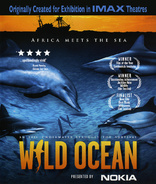Wild Ocean Blu-ray Movie
HomeWild Ocean Blu-ray Movie 
IMAXImage Entertainment | 2008 | 40 min | Not rated | Jan 26, 2010
Movie rating
7 | / 10 |
Blu-ray rating
| Users | 4.5 | |
| Reviewer | 4.0 | |
| Overall | 4.0 |
Overview
Wild Ocean (2008)
Wild Ocean is an uplifting cinematic experience capturing one of nature's greatest migration spectacles through the magic of IMAX. Plunge into an underwater feeding frenzy amidst the dolphins, sharks, whales, gannets, seals and billions of fish. Filmed off the Wild Coast of South Africa, Wild Ocean is a timely documentary that celebrates the animals that now depend on us to survive and the efforts by local people to protect this invaluable ecological resource. Hope is alive on the Wild Coast where Africa meets the sea.
Director: Luke Cresswell, Steve McNicholas| Documentary | Uncertain |
| Nature | Uncertain |
Specifications
Video
Video codec: VC-1
Video resolution: 1080p
Aspect ratio: 1.78:1
Original aspect ratio: 1.85:1
Audio
English: DTS-HD Master Audio 5.1
French: DTS-HD Master Audio 5.1
Spanish: DTS-HD Master Audio 5.1
Subtitles
None
Discs
25GB Blu-ray Disc
Single disc (1 BD)
Playback
Region A (B, C untested)
Review
Rating summary
| Movie | 4.0 | |
| Video | 4.0 | |
| Audio | 4.0 | |
| Extras | 2.5 | |
| Overall | 4.0 |
Wild Ocean Blu-ray Movie Review
Where Africa Meets the Sea
Reviewed by Casey Broadwater January 11, 2010Most documentaries with a pointed environmental message feel the need to resort to scare tactics and guilt trips to impress the audience with the seriousness of the issue. And fair enough, between global warming, water shortages, and a looming lack of natural resources like fossil fuels, the situation does seem dire. A few months ago I reviewed Yann Arthus-Bertrand’s Home, and while I was moved by the stunning aerial footage of the Earth, the dourness of the film’s look what we’ve done to our planet message left me feeling both guilty and helpless, as if I was solely responsible for the environmental state of affairs and also tasked with the Sisyphean undertaking of cleaning it all up. It seems to me that this shock and awe approach to environmental awareness actually undermines the film’s message. Fear and guilt certainly can be motivators— granted, not the healthiest motivators—but Home only gave me a resigned sense of futility. A more positive tact, I think, is to show examples of places on Earth where humans have a balanced coexistence with the rest of the natural world, to focus on what’s worth saving and not so heavily on what we’ve already lost. And that’s exactly what the 2008 IMAX film Wild Ocean does; it teaches rather than preaches, and it reminds us that the bounty of the ocean’s resources is something we share with a complex and delicate marine ecosystem.
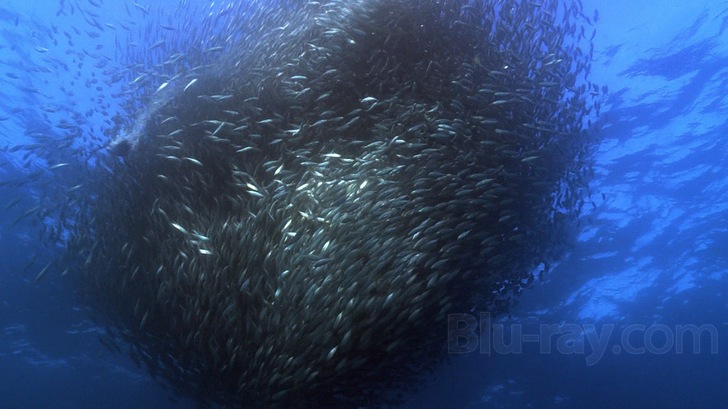
A "bait ball" of sardines...
Wild Ocean takes us to the unspoiled waters off of South Africa’s appropriately named Wild Coast, an area that has one of the world’s highest concentrations of marine predators. The main draw—for the predators and viewers of this IMAX film—is the Sardine Run, an annual mass migration that occurs when cold-water currents push shoals of sardines into the shallow waters off of Kwazulu Natal. These sardines aren’t quite at the bottom of the food chain, but they are prey for a number of predators. Bottlenose and common dolphins convene off the Wild Coast and form a superpod some 20,000 strong, all awaiting the incoming shoals, black masses that, from the air, can easily be mistaken for oil spills.
In one of the film’s most striking scenes, we see a shoal form an enormous “bait ball,” a swarming sphere of sardines that acts with a communal consciousness in order to confuse and evade predators. As penguins and cape fur seals dart in, trying to grab a snack, the bait ball morphs and flashes like quicksilver in a collective response to danger. It’s simply breathtaking to behold, and I don’t say that lightly. Later, in an equally impressive display, black-tipped gannets— large, fish-eating seabirds—dive bomb into the ocean at 30 miles per hour, leaving long plumes of bubbles behind them. It truly is a feeding frenzy, with dolphins, sharks, penguins, gulls, and seals —all relatively unconcerned with one another—competing for the sardine spoils.
Humans get in on the action too, gathering on the beach to scoop up sardines by the ton in giant nets, but the South African government has wisely imposed catch limits to prevent over-fishing. They’ve also been a global leader in creating offshore wildlife reserves, with 20% of the nation’s coastline currently protected under law. This, in a world where only one hundredth of one percent of the oceans is protected, compared to a full 12% of all land. But we also learn that South Africa’s legislature alone is not enough to protect the Sardine Run. As global warming creates a rise in ocean temperatures, sardines will inevitably seek cooler waters further from the coast. Still, creating non-fishable marine reserves and implementing sustainable fishing practices will go a long in strengthening a food chain that’s easily broken. French scientist Marcel Heubel first proposed the idea of protected waters in 1912, but by this time, great swaths of the North American and European coastlines had already been over-fished, and natural events even larger in scale than the Sardine Run were wiped out forever.
These facts may be depressing, but Wild Ocean is actually one of the most joyously life- celebrating IMAX films I’ve seen yet, filled with the kind of awe-inspiring footage that makes up lengthier productions like Planet Earth and The Blue Planet. My only complaint then—and this goes for most IMAX films—is that it feels a bit too short and not as in-depth as it could be, more of a morsel than a meal. That said, directors Luke Cresswell and Steve McNicholas —the creators of the percussion troupe STOMP—have discovered a subject that fits perfectly into the typical IMAX equation: a forty minute film that’s educational, entertaining, and suitable for a wide audience. The Salmon Run off the coast of Kwazulu Natal is an inherently cinematic circle of life story, the cinematography is simply stunning, and anyone who enjoys nature documentaries will sit in amazement at the glorious 70mm IMAX image. What I appreciated most, though, was the film’s energetic and inspiring tone, that it couches its conservationist message in beauty and appreciation, rather than guilt and fear. Instead of wagging a blame-placing finger in our faces, Wild Ocean points to a breathtaking natural phenomenon that subtly reminds us of why we should care about our planet’s oceans in the first place.
Wild Ocean Blu-ray Movie, Video Quality 
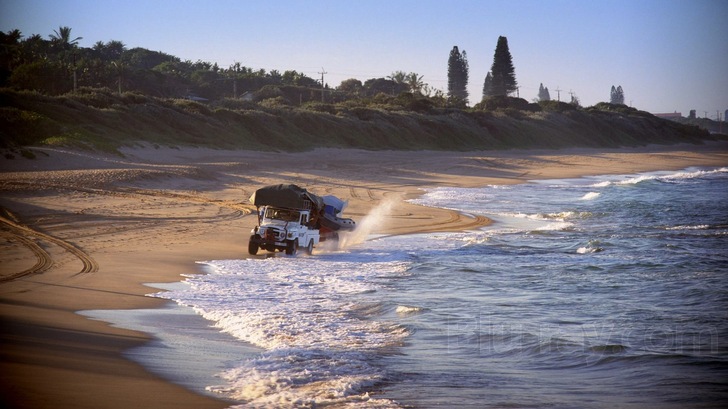
Courtesy of Image Entertainment, Wild Ocean arrives on Blu-ray with an expectedly
gorgeous 1080p/VC-1 encoded transfer. The above-water portions of the film look especially
fantastic, even bordering on reference level quality at times. The large format 70mm negative
provides exceptional clarity, and it's all reproduced here with little trouble. Grains of sand, blades
of grass, and ripples of water are individually apparent, craggy rock faces show off exemplary
detail, and the sense of depth and presence in the image is consistently impressive. Likewise,
saturated colors burst forth frequently, from the vivid oranges of a South African sunrise, to the
bright, multi-hued clothing worn by women gathering shellfish on the shore. Black levels are
faultless, highlights are never overblown, and tight contrast gives the image appropriate pop.
Unfortunately—but understandably—things falter ever so slightly when we dive under the ocean.
Diffused by water, the image softens up considerably and takes on a slightly murky quality. It still
looks great, just not nearly as impressive as the out-of-water experience. I did spot a few tiny
specks on the print, but as a whole the technical presentation is pure, with no artificial
sharpening, excessive noise, DNR, or compression issues.
Do note that Wild Ocean was shot natively in IMAX 3D, and I'm sure that, like Sea
Monsters, the film will eventually be re-released on Blu-ray in 3D. Time will tell whether this
will be in anaglyphic format or using some of the new technology debuted last weekend at CES.
Wild Ocean Blu-ray Movie, Audio Quality 
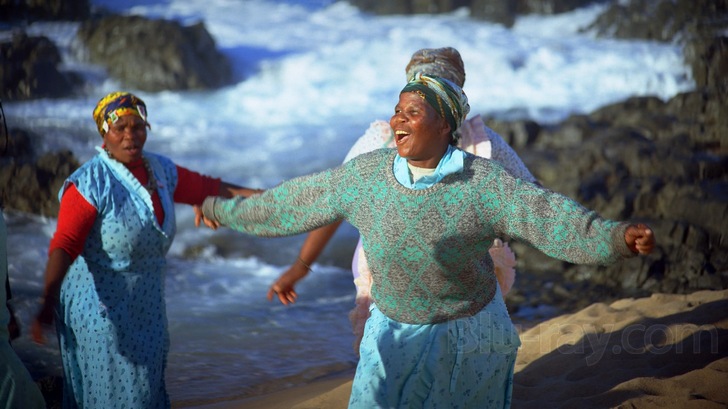
Image has loaded up Wild Ocean with three DTS-HD Master Audio 5.1 surround tracks—one each for English, Spanish, and French-speaking viewers. I went with the English track and found it to be a wonderfully weighty, detailed, and immersive experience. The surround channels are intelligently engaged, and you'll regularly hear the squeals and chatter of dolphins, gulls squawking and flying through the rears, and water gurgling and bubbling throughout the soundfield. The score —which mixes orchestral elements with traditional African instrumentation—is energetic and grand, with a crisp differentiation between individual sounds and surprisingly potent bass. My sole complaint is that the narration by native South African John Kani seems low in the mix and overshadowed at times by the raucous sounds we hear in the rear speakers. Still, I didn't have to much trouble understanding what was being said, and I appreciate the sound designer's attempts to make us feel like we're underwater with the cameramen.
Wild Ocean Blu-ray Movie, Special Features and Extras 
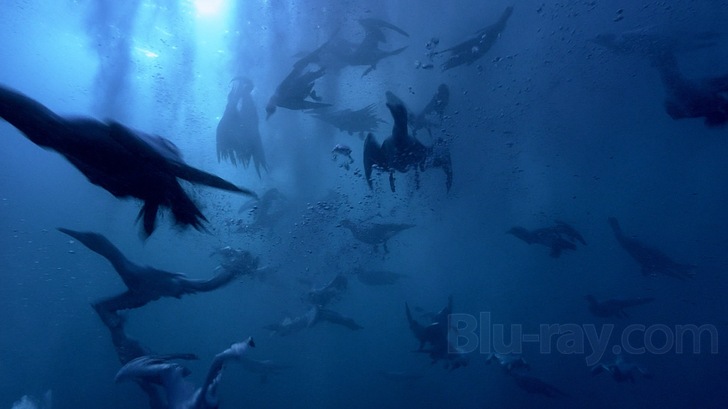
Interview with Directors (1080p, 15:56)
Directors Luke Cresswell and Steve McNicholas explain how their original intentions to simply
make a fantastic IMAX 3D experience shifted as their research opened their eyes to the
importance of marine conservation. They also detail some of the challenges of shooting with an
IMAX 3D rig on the open seas, and reveal the amount of the luck that was required to capture
the enormous "bait balls" on film. Apparently, they shot for 12 weeks, and most of the footage
used in the film was from the last two days of shooting.
Do note that while this and the
rest of the special features technically play in 1080p, the footage has been upscaled from a 720p
source.
Kwazulu Natal During the Run (1080p, 6:31)
This short feature documents life in Kwazulu Natal during the Sardine Run, showing the
communal fishing efforts that take place on the beach, the packing and freezing process, and
even an annual soapbox derby.
Behind-the-Scenes (1080p, 8:39)
Camera geeks and scuba enthusiasts will get a kick out of this behind-the-scenes featurette,
which shows the crew manhandling the enormous IMAX 3D rig underwater and on shore. There's
also lots of random on-set footage.
Recording Wild Ocean (1080p, 2:23)
Watch as conductor Dominic Nuns leads an orchestra through one particularly dizzying piece of
the film's score.
Shooting Wild Ocean (1080p, 7:13)
An impressive gallery of still photography captured during the shooting of the film, set to the
film's score.
Who, What & Where
This section, which consists of text and accompanying photographs, gives condensed information
about the Sardine Run, the wildlife featured in the film, and the film's creators.
Film Trivia Quiz
A ten question, remote-controlled, multiple choice quiz that tests your knowledge of the
film.
Trailers
Includes two trailers for Wild Ocean, and trailers for Pulse, Mummies:
Secrets of the Pharaohs, and Dinosaurs Alive!
Wild Ocean Blu-ray Movie, Overall Score and Recommendation 
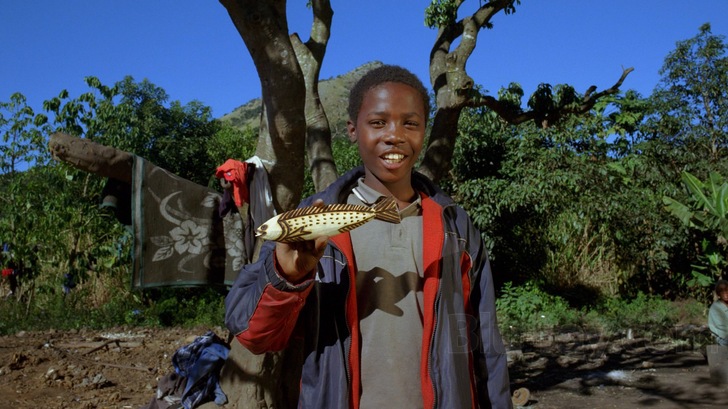
I've reviewed quite a few IMAX films in the past few months, and I can say without hesitation that Wild Ocean is my favorite, combining a pertinent but non-obtrusive conservationist message with beautiful cinematography and a joyful sense of life-affirming energy. Plus, seeing a "bait ball" of sardines effectively evade attack is probably the most mindblowingly awesome natural event I've seen on film all year. This is one IMAX film that should truly appeal to everyone, and my only reservation about recommending Wild Ocean is that a 3D reissue seems inevitable.
Similar titles
Similar titles you might also like
(Still not reliable for this title)

Dinosaurs Alive!
IMAX
2007

Grand Canyon Adventure: River at Risk 3D
IMAX 3D
2008

3D Safari: Africa
2011

Dinosaurs: Giants of Patagonia 3D
IMAX
2007

Mummies: Secret of the Pharaohs
IMAX
2007

The Ultimate Wave: Tahiti 3D
IMAX
2010

Deep Sea 3D
IMAX
2006

Under the Sea
IMAX
2009

Galápagos 3D
IMAX
1999

IMAX: Hubble 3D
2010

Sea Rex 3D: Journey to a Prehistoric World
2010

Into the Deep 3D
IMAX
1994

Space Station 3D
IMAX
2002

Legends of Flight 3D
IMAX
2010

The Universe: The Complete Season Seven
Ancient Mysteries Solved
2013

Ocean Wonderland 3D
2003

Dolphins and Whales: Tribes of the Ocean 3D
2008

Sharks 3D
2004

3D Aquarium
2011

Flying Monsters 3D
2011
